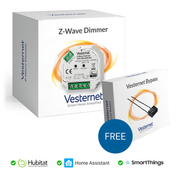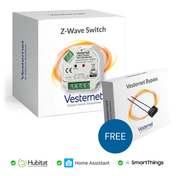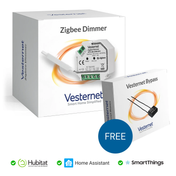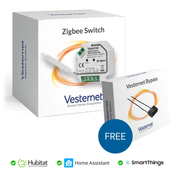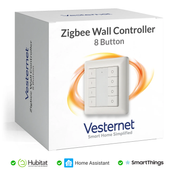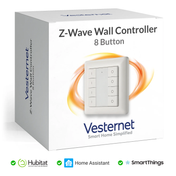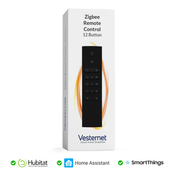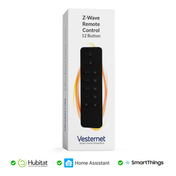IMPORTANT - Read this first!
Note: To simplify these diagrams, we have not shown the earth cables - but all circuits MUST have the earth cable correctly installed.
We've shown wires in red to indicate that they are new wires, but it doesn't really matter what colour you use.
To protect the module a suitable rated overcurrent protection fuse must be installed on the Live input.
We work hard to keep these wiring guides accurate and up to date and would appreciate any feedback, corrections or suggestions that you may have. Please contact us using our help page or by simply emailing feedback@vesternet.com
One of the things that confuses people the most is installing home automation into an existing 2-Way lighting system. This application note looks at how a Aeotec Nano Dimmer module can be installed to control a standard 2-Way lighting system.
Firstly, what do we mean by 2-Way lighting?
This simply refers to a lighting system where one light is controlled by two light switches. Examples of this are where a room has two entrances (each needs a light switch) or for a hall light that can be controlled from the hall and the upstairs landing.
This guide provides alternative ways to use a Aeotec Nano Dimmer module in a 2-way lighting system. This is a different style of creating a 2-way lighting circuit used in some countries but uncommon in most UK buildings. It uses a 2-core (+ earth) cable between the two switches, instead of the more typical 3-core (+ earth) cable.
More information about 2-wire lighting systems is available in APNT-23: Understanding 2-wire and 3-wire Lighting Systems.
For information on how to physically install a Z-Wave module take a look at our guide here.
To know more about how Z-Wave modules work with different switch types make sure to read our guide here.
Alternate 2-Way Lighting Circuit
 Figure 1: Alternate 2-Way Lighting Circuit
Figure 1: Alternate 2-Way Lighting Circuit
This system uses a 2-core (+ earth) cable between the two switches, instead of the more typical 3-core (+ earth) cable. The main challenge with this system is that neither Switch locations have access to both Permanent Live and Switched Live.
This type of lighting system uses "Toggle" (latching) switches. These latch in position - for instance when you press the switch to On, the switch physically stays in the On position. These are the standard light switches you'll find already fitted in your home.
The module can also be used with a variety of "Momentary" switch types and configurations. Momentary switches, also known as Retractive or Bell-Push, only remain in the On state while you press them, they return to the Off state when the button is released.
This doesn't mean that you have to keep holding the button to keep the light on. The module's internal controls automatically keep the light on when the button is released.
More information about how the Aeotec Nano Dimmer works with different switch types is available here.
We can install the module into the 2-Way circuit in various different ways shown below. We've separated out the diagrams based on whether you need to install the module at Switch A or Switch B position.
Aeotec Nano Dimmer Connections
The Aeotec Nano Dimmer has six terminals to connect it to the electrical wiring:
|
|
|
Aeotec Nano Dimmer Parameter Setting:The following parameters may need to be set:
|
Installation at Switch A position
You will install the module at the Switch A position where it has access to Permanent Live.
Toggle Switches - add additional wire between switches
To retain your existing standard Toggle switches, we can simple install the Aeotec Nano Dimmer module as shown in Figure 2.
 Figure 2: Alternate 2-Way Lighting Circuit using the Aeotec Nano Dimmer with Toggle switches (Switch A).
Figure 2: Alternate 2-Way Lighting Circuit using the Aeotec Nano Dimmer with Toggle switches (Switch A).
In this case we keep the standard Toggle switches connecting Switch A "L1" to the module's S1 input and Switch B "L1" to the module's S2 input with the "COM" wire connected to the module's COM output. Live is wired to L terminal and an additional wire is added to take Switched Live to the Load.
The module is then configured to accept S2 as the second switch control of the module.
This gives simple On / Off control of the light from the switches but you will still be able to control the dimming level over Z-Wave if required.
Aeotec Nano Dimmer Parameter Setting:
The following parameters need to be set:
- 120 - 3 - enables the modules' S1 to work with a toggle switch
- 124 - 1 - enables the modules' S2 switch to also control the load (default)
Momentary Switches - add additional wire between switches
For full On / Off and dimming control we can replace the Toggle wall switches with similar styled Momentary switches.
 Figure 3: Alternate 2-Way Lighting Circuit using the Aeotec Nano Dimmer with Momentary switches (Switch A).
Figure 3: Alternate 2-Way Lighting Circuit using the Aeotec Nano Dimmer with Momentary switches (Switch A).
By using Momentary switches, the 2-Way wiring can be simplified - connect both Switch A and Switch B "L1" to the module's S1 input with the "COM" wire connected to the module's COM output. Live is wired to L terminal and an additional wire is added to take Switched Live to the Load.
Aeotec Nano Dimmer Parameter Setting:
The following parameters need to be set:
- 120 - 1 - enables the modules' S1 to work with momentary switch (default)
Toggle Switches - re-wire Switched Live to Switch A
 Figure 4: Alternate 2-Way Lighting Circuit using the Aeotec Nano Dimmer with Toggle switches (Switch A).
Figure 4: Alternate 2-Way Lighting Circuit using the Aeotec Nano Dimmer with Toggle switches (Switch A).
In this case we keep the Toggle switches connecting Switch A "L1" to the module's S1 input and Switch B "L1" to the module's S2 input with the "COM" wire connected to the module's COM output. Live is wired to L terminal and re-wire Switched Live (Dimmer Output) to Switch A.
The module is then configured to accept S2 as the second switch control of the module.
This gives simple On / Off control of the light from the switches but you will still be able to control the dimming level over Z-Wave if required.
Aeotec Nano Dimmer Parameter Setting:
The following parameters need to be set:
- 120 - 3 - enables the modules' S1 to work with a toggle switch
- 124 - 1 - enables the modules' S2 switch to also control the load (default)
Momentary Switches - re-wire Switched Live to Switch A
For full On / Off and dimming control we can replace the Toggle wall switches with similar styled Momentary switches.
 Figure 5: Alternate 2-Way Lighting Circuit using the Aeotec Nano Dimmer with Momentary switches (Switch A).
Figure 5: Alternate 2-Way Lighting Circuit using the Aeotec Nano Dimmer with Momentary switches (Switch A).
By using Momentary switches the 2-Way wiring can be simplified - connect both Switch A and Switch B "L1" to the module's S1 input and the "COM" wire to the module's COM output. Live is wired to L terminal and re-wire Switched Live (Dimmer Output) to Switch A.
Aeotec Nano Dimmer Parameter Setting:
The following parameters need to be set:
- 120 - 1 - enables the modules' S1 to work with momentary switch (default)
2-Way with Z-Wave Wall Switch
Sometimes you may require a 2-Way or multi-way lighting circuit where physical wiring doesn't already exist, or perhaps you need to re-purpose the existing wiring for something else.
Z-Wave makes this possible using something known as "Associations" - where one Z-Wave device can control another Z-Wave device directly without inter-connecting wiring. More information on Associations can be seen in our guides here and here.
 Figure 6: Using Z-Wave Switches in a Standard 2-Way Lighting Circuit with Aeotec Nano Dimmer. (Switch A).
Figure 6: Using Z-Wave Switches in a Standard 2-Way Lighting Circuit with Aeotec Nano Dimmer. (Switch A).
To create this circuit you simply install the module to suit either Toggle or Momentary switches and safely terminate the 3-Core cable as required. A battery powered Z-Wave Wall Controller can then be Associated to the module.
Don't forget to configure the module for Toggle or Momentary switches!
Any unused wires from the original 2-core between the two switches should be safely terminated.
Installation at Switch B position
You will install the Aeotec Nano Dimmer module at the Switch B position where it has access to Switched Live.
Toggle Switches - add additional wire between switches
To retain your existing standard Toggle switches, we can simple install the module as shown in Figure 7.
 Figure 7: Alternate 2-Way Lighting Circuit using the Aeotec Nano Dimmer with Toggle switches (Switch B).
Figure 7: Alternate 2-Way Lighting Circuit using the Aeotec Nano Dimmer with Toggle switches (Switch B).
In this case we keep the standard Toggle switches connecting Switch A "L1" to the module's S1 input and Switch B "L1" to the module's S2 input with the "COM" wire connected to the module's COM output. An additional wire is added to take Live to Switch B position.
The module is then configured to accept S2 as the second switch control of the module.
This gives simple On / Off control of the light from the switches but you will still be able to control the dimming level over Z-Wave if required.
Aeotec Nano Dimmer Parameter Setting:
The following parameters need to be set:
- 120 - 3 - enables the modules' S1 to work with a toggle switch
- 124 - 1 - enables the modules' S2 switch to also control the load (default)
Momentary Switches - add additional wire between switches
For full On / Off and dimming control we can replace the Toggle wall switches with similar styled Momentary switches.
 Figure 8: Alternate 2-Way Lighting Circuit using the Aeotec Nano Dimmer with Momentary switches (Switch B).
Figure 8: Alternate 2-Way Lighting Circuit using the Aeotec Nano Dimmer with Momentary switches (Switch B).
By using Momentary switches the 2-Way wiring can be simplified - connect both Switch A and Switch B "L1" to the module's S1 input and the "COM" wire to the module's COM output. An additional wire is added to take Live to Switch B position.
Aeotec Nano Dimmer Parameter Setting:
The following parameters need to be set:
- 120 - 1 - enables the modules' S1 to work with momentary switch (default)
Toggle Switches - re-wire Live to Switch B
 Figure 9: Alternate 2-Way Lighting Circuit using the Aeotec Nano Dimmer with Toggle switches (Switch B).
Figure 9: Alternate 2-Way Lighting Circuit using the Aeotec Nano Dimmer with Toggle switches (Switch B).
In this case we keep the standard Toggle switches connecting Switch A "L1" to the module's S1 input and Switch B "L1" to the module's S2 input with the "COM" wire connected to the module's COM output. Re-wire Live to Switch B position.
The module is then configured to accept S2 as the second switch control of the module.
This gives simple On / Off control of the light from the switches but you will still be able to control the dimming level over Z-Wave if required.
Aeotec Nano Dimmer Parameter Setting:
The following parameters need to be set:
- 120 - 3 - enables the modules' S1 to work with a toggle switch
- 124 - 1 - enables the modules' S2 switch to also control the load (default)
Momentary Switches - re-wire Live to Switch B
For full On / Off and dimming control we can replace the Toggle wall switches with similar styled Momentary switches.
 Figure 10: Alternate 2-Way Lighting Circuit using the Aeotec Nano Dimmer with Momentary switches (Switch B).
Figure 10: Alternate 2-Way Lighting Circuit using the Aeotec Nano Dimmer with Momentary switches (Switch B).
By using Momentary switches the 2-Way wiring can be simplified - connect both Switch A and Switch B "L1" to the module's S1 input and the "COM" wire to the module's COM output. Re-wire Live to Switch B position.
Aeotec Nano Dimmer Parameter Setting:
The following parameters need to be set:
- 120 - 1 - enables the modules' S1 to work with momentary switch (default)
2-Way with Z-Wave Wall Switch
 Figure 11: Using Z-Wave Switches in a Standard 2-Way Lighting Circuit with Aeotec Nano Dimmer. (Switch B).
Figure 11: Using Z-Wave Switches in a Standard 2-Way Lighting Circuit with Aeotec Nano Dimmer. (Switch B).
Here we replace Switch A with a Z-Wave Wall Switch. Connect Switch B “L1” to the module's S1 input with the "COM" wire connected to the module's COM output. We use the original "L1" wire to bring over Live from Switch A position to Switch B position.
Any unused wires from the original 2-core between the two switches should be safely terminated.
A battery powered Z-Wave Wall Controller can then be Associated to the module. More information on Associations can be seen in our guides here and here.
Install at Switch B and use S2 from Nano Dimmer at Switch A
 Figure 12: Install at Switch B and use S2 from Nano Dimmer at Switch A.
Figure 12: Install at Switch B and use S2 from Nano Dimmer at Switch A.
Here we connect Switch A “L1” to Module A S2 input. Connect Switch C “L1” to the Module B S1 input with the "COM" wire connected to the Module B COM output. We use the original "L1" wire to bring over Live from the first switch position.
Any unused wires from the original 3-core between the two switches should be safely terminated.
More information on how to use a Secondary Switch with a Aeotec Nano Dimmer module can be found here.
Note: power to module at Switch A not shown as this would typically be taken care of for switching the other gang in a 2-gang switch.


